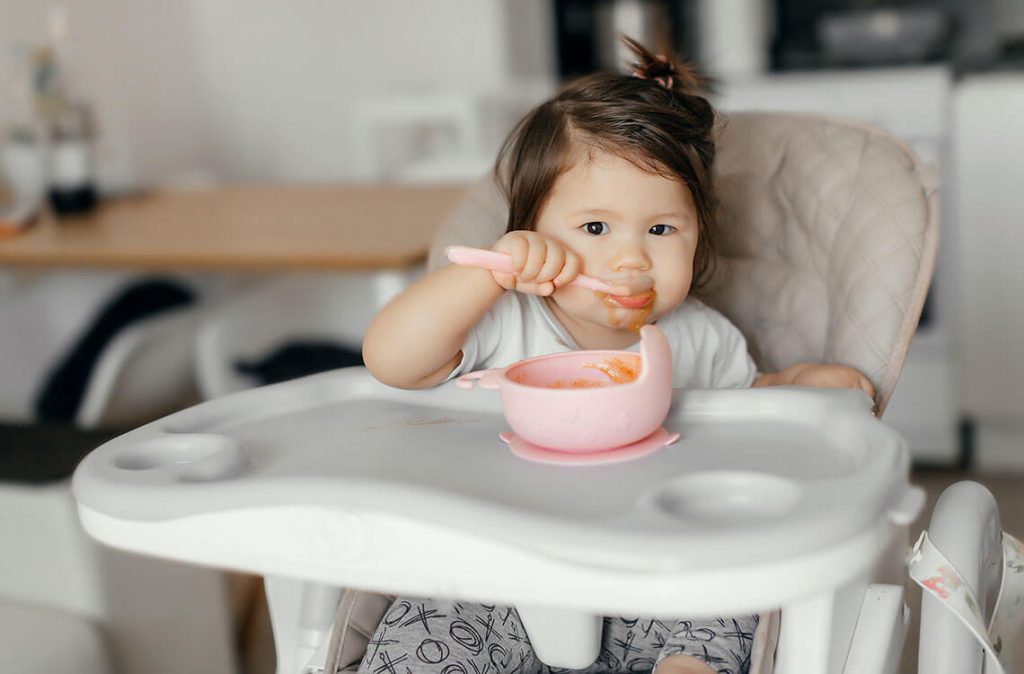The diet of a two-year old will not be that much different from that of a one-year-old except in terms of portions.
A two-year old may want to eat a little bit more just to catch up with their growth spurts.
At two years old your toddler should be expending a lot more energy playing and learning.
So, you will need to up their caloric intake (anywhere between 1000 to 1200 calories depending on their height and weight).
But it’s important not to overthink this.
While it’s okay to start indulging them every now and again with treats like chocolate, it’s important not to do so often.
Sticking to healthy, whole foods is the best.
Here are some tips on how you can plan their diet.
What to Feed
Protein Sources
Protein is vital for growth and development. Offer lean meats such as chicken, turkey, and fish.
Legumes, such as lentils and beans, are excellent vegetarian protein sources.
Eggs and dairy products like milk, yoghurt, and cheese also provide essential protein.
Your child will want to explore their taste buds more at two-years-old.
So, give them more interesting foods like omelettes, chicken cutlets and fish patties.
Good Carbs
Include whole grains in your child’s diet for a good source of fibre and energy.
Opt for whole wheat bread, brown rice, oatmeal, and whole grain cereals.
These foods promote healthy digestion and provide a steady release of energy throughout the day.
However, since they are older now you can make more interesting things for them to eat.
You may consider sandwiches, spaghetti bolognese or fried rice.
Fruits and Vegetables
Encourage your two-year-old to consume a variety of fruits and vegetables.
These provide essential vitamins, minerals, and dietary fibre.
Offer a mix of colours and textures to make it more appealing.
Incorporate options like bananas, apples, berries, broccoli, carrots, and spinach into their meals and snacks.
Think toddler-friendly fruit salads, green salads and fruit punch.
Just remember to slice the ingredients very finely to avoid choking.
Healthy Fats
Healthy fats are crucial for brain development. Include sources like avocados, nut butters (if there are no allergies), and olive oil in your child’s meals.
These fats aid in the absorption of vitamins and contribute to their overall growth and development.
However, it’s important to avoid whole nuts as this can prove to be a choking hazard.
Dairy Products
Continue to include dairy products in your child’s diet, as they provide essential nutrients like calcium and vitamin D.
They are now old enough to drink whole milk instead of formula.
Other dairy sources include unprocessed cheese and unsweetened yogurt are good dairy sources.
If your child has a lactose intolerance or any specific dietary restrictions, consult with a healthcare professional for suitable alternatives like almond milk.
What Not to Feed
Added Sugars
As with children of all ages, added sugars need to be limited or eliminated entirely from the diet.
Avoid giving your two-year-old foods and drinks high in added sugars.
These include sodas, fruit juices with added sugar, candies, and sugary snacks.
Excessive sugar intake can lead to tooth decay and contribute to the risk of obesity and other health issues.
Processed Food
Minimise the consumption of processed and packaged foods, as they often contain high amounts of sodium, unhealthy fats, and additives.
Instead, opt for fresh and whole foods to ensure your child receives optimal nutrition.
Choking Hazards
Be cautious of foods that pose a choking hazard, as two-year-olds are still developing their chewing and swallowing skills.
Avoid giving your child whole grapes, popcorn, nuts, hard candies, and large chunks of meat or vegetables.
Cut food into small, bite-sized pieces and supervise mealtime closely.
Unhealthy Fats
While healthy fats are essential, it is crucial to avoid unhealthy fats, such as those found in fried and processed foods.
These fats can negatively impact your child’s health and increase the risk of obesity and heart problems.
Allergenic Foods
Introduce potentially allergenic foods one at a time and monitor your child’s reaction.
Common allergenic foods include peanuts, tree nuts, shellfish, eggs, and wheat.
Consult with your paediatrician before introducing these foods if there is a family history of allergies.
Nourish Your Child
Feeding your two-year-old a nutritious and balanced diet lays the foundation for their lifelong health and well-being.
Offer a variety of fruits, vegetables, whole grains, lean proteins, and healthy fats to provide them with essential nutrients.
Avoid foods high in added sugars, processed foods, choking hazards, unhealthy fats, and potential allergens.
For more insightful stories and fun recipes, stay tuned to Motherhood Story!
